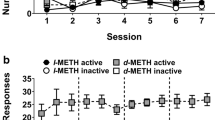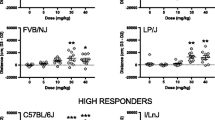Abstract.
Background: Because of the amphetamines' abuse potential and capability of exacerbating or inducing mood and psychotic disturbances, investigations of the behavioral effects of amphetamines commonly involve non-human animals, with the laboratory rat being by far the most common species used. Although investigators of the behavioral effects of amphetamine in rats sometimes refer to doses used as being "low", "moderate", "high", etc., it is not clear in what sense these terms apply. Objectives: To develop an operational definition of a low dose of amphetamine in rats, we reviewed studies that assessed the behavioral effects of dextroamphetamine (d-AMP) in rats in which some subset of doses, administered SC, IM or IP, was described as being "low". We then used the results of these studies to establish what the lowest effective dose ranges were across a variety of behavioral domains and compared these doses and their effects with those obtained with normal, healthy adult humans. Results: While the range of the lowest doses used in the studies with rats was quite broad (0.025–2.0 mg/kg), the median lowest effective doses observed (in the studies using doses of 0.125 mg/kg or less) were between 0.125 and 0.165 mg/kg across the behavioral domains of consummatory behavior, unconditioned or spontaneous behavior, learned behavior, and drug discriminative control. This range of doses was also found to be comparable to the lowest behaviorally effective doses of d-AMP (SC or PO) in normal human adults, which suggests that the sensitivity to the behavioral effects of amphetamine in these two species is fairly comparable. Conclusions: Because of their ability to alter a wide variety of behaviors in rats, we conclude that low doses of d-AMP are in the 0.1–0.4 mg/kg range. Doses within this range typically: 1) constitute the ED50 in most drug discrimination/generalization procedures; 2) increase a variety of consummatory behaviors; 3) increase a variety of unconditioned or spontaneous motor activities; 4) increase low rate schedule-controlled behavior while exerting variable effects on high rate schedule controlled behavior; and 5) improve performance on some choice tasks, particularly those requiring sustained attention. Our analyses also indicate that, with respect to behavior, investigators do not always agree on what constitutes a low dose of amphetamine in rats and that doses assumed to be low for this species often are relatively high.
Similar content being viewed by others
Author information
Authors and Affiliations
Additional information
Electronic Publication
Rights and permissions
About this article
Cite this article
Grilly, D., Loveland, A. What is a "low dose" of d-amphetamine for inducing behavioral effects in laboratory rats?. Psychopharmacology 153, 155–169 (2001). https://doi.org/10.1007/s002130000580
Received:
Accepted:
Issue Date:
DOI: https://doi.org/10.1007/s002130000580




